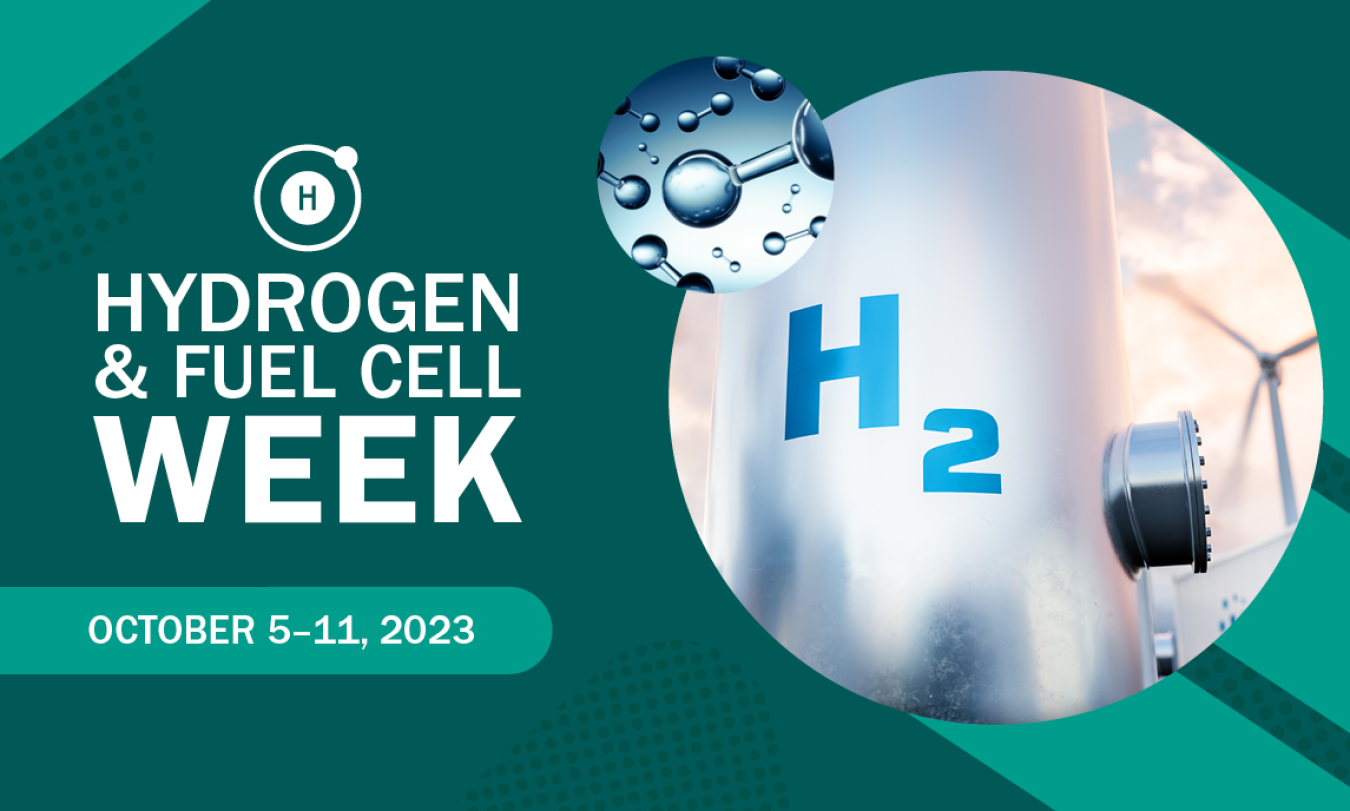Hydrogen Day and Hydrogen Week mark a symbolic opportunity to celebrate hydrogen—clean hydrogen, specifically—and the crucial role this element plays in supporting a robust, equitable clean energy future for all Americans.
Hydrogen and Fuel Cell Technologies Office
October 5, 2023
Welcome to Hydrogen Week 2023!
As many of you know, Hydrogen Day is October 8 each year. Why? Because the date 10/08 shares the same sequence of numbers as the atomic weight of hydrogen: 1.008.
This year, since October 8 falls on a Sunday, we're celebrating hydrogen for an entire week, from today through October 11.
Hydrogen Day and Hydrogen Week mark a symbolic opportunity to celebrate hydrogen—clean hydrogen, specifically—and the crucial role this element plays in supporting a robust, equitable clean energy future for all Americans.
And this year, we have a lot to celebrate—particularly the launch of the new U.S. National Clean Hydrogen Strategy and Roadmap. This is not just a DOE strategy, but a strategy that draws on input from multiple agencies across your federal government as well as extensive and insightful feedback received from stakeholders across the nation during a public comment period. It is truly a national American strategy—it's your strategy.
To kick things off, let's look at some key facts about hydrogen in America today.
- We already produce and use a lot of hydrogen. More than 10 million metric tons (MMT) of hydrogen are produced each year in the United States. That hydrogen contains almost as much energy as the petroleum fuel used annually by every commercial light-truck, bus, and passenger train in the United States combined!
- Hydrogen is already essential to our everyday lives. We may not interact with it directly every day, but hydrogen is used in industrial and chemical applications such as petroleum refining and fertilizer production—important processes that are essential to our quality of life. Hydrogen is also used in food processing, steel manufacturing, and cosmetics.
- Hydrogen is already hard at work moving goods and people. Hydrogen has a growing role in transportation and material-handling applications, with more than 70,000 hydrogen-powered forklifts already moving consumer goods in America's warehouses and growing investments in clean hydrogen for heavy-duty transportation like long-haul trucks and transit buses.
What does the future hold for hydrogen?
- We're transitioning quickly to clean hydrogen. Our national goal is to produce 10 MMT per year of clean hydrogen by 2030. Clean hydrogen is produced with low or zero emissions, using renewables, nuclear power, or fossil resources with carbon capture. Most of today's hydrogen is made from natural gas (without carbon capture), so this is an ambitious goal!
- Clean hydrogen will be used in even more applications. As costs come down and other barriers are overcome, clean hydrogen will be instrumental in a number of "hard-to-decarbonize" sectors, including heavy-duty transportation, industrial and chemical processes, synthetic fuels, and long-duration energy storage.
- We're going to produce and use a lot more clean hydrogen. Our new national clean hydrogen strategy sets an ambitious target of producing 50 MMT per year of clean hydrogen in the United States by 2050, which will be essential for achieving President Biden's ambitious goal of a net-zero-emissions economy by that same year.
There are plenty of fun and educational activities you can do to celebrate Hydrogen Week.
Here are a few suggestions:
- Walk or run 1.008 miles or kilometers (your smartphone can help track an exact measurement). Or if you're feeling particularly energetic, make it 10.08! Then brag to the world about it with a social media post tagging #H2DayWalk or #H2DayRun with a picture and one of our awesome H2 walk/run graphics or a customized certificate!
- Follow EERE on Facebook, Twitter, and LinkedIn and share your photo. Maybe even add something new and interesting you've learned about hydrogen. Don't forget to tag #NationalHydrogenDay in your post.
- Speaking of facts about hydrogen: did you know that 10% of your body weight is actually hydrogen? Learn more hydrogen facts from our hydrogen and fuel cells posters!
- Increase your H2IQ by accessing valuable DOE resources, including fact sheets, introductory materials, and multimedia including infographics, videos, and animations.
- Use DOE's hydrogen career map to learn more about a wide range of opportunities to work in clean hydrogen.
- Ready for a deeper dive? The U.S. National Clean Hydrogen Strategy and Roadmap released earlier this year explores detailed ways in which clean hydrogen can contribute to national decarbonization goals across the economy.
- Subscribe to Hydrogen and Fuel Cell Technologies Office (HFTO) news for the latest updates on hydrogen and fuel cell technologies and receive invites to webinars and events throughout the year.
- In recognition of Hydrogen Day, student teams from 190 countries are gathered in Singapore to compete in FIRST Global's Hydrogen Horizons Challenge, October 7–10. Follow the challenge and learn more about how student teams are using creativity and problem-solving skills to design and build a robot—yes, robot—that they must navigate in a simulation to produce hydrogen and use it to store, transport, and convert energy.
We've made great strides in clean hydrogen technology R&D recently, particularly in areas related to cost reduction. But more work needs to be done, and not just in advancing the technologies.
The federal government is making unprecedented investments to overcome all the barriers to clean hydrogen today—from advancing technologies in the laboratory, to deploying them in the field, to addressing safety and environmental concerns and ensuring the benefits of clean hydrogen are shared equitably across all communities. The Hydrogen Interagency Task Force (HIT)—a historic collaboration across 11 federal agencies—will further advance a whole-of-government approach to executing the national strategy. DOE's Hydrogen Program, led by HFTO, is a proud member of that task force. Read more about the HIT, the DOE Hydrogen Program, and HFTO.

